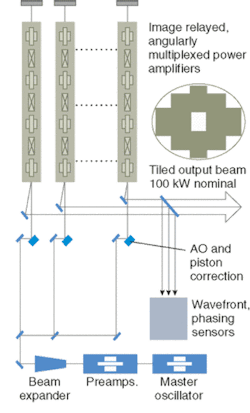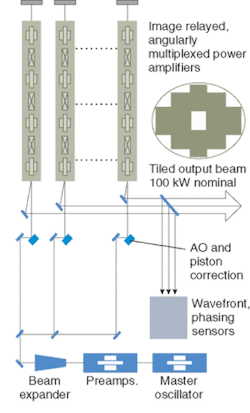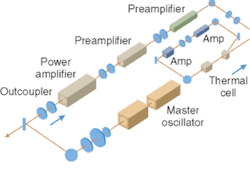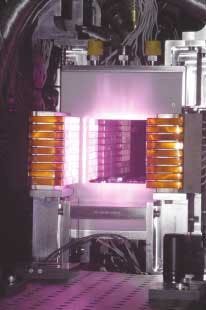Laser weapons go solid-state
Enhancements in solid-state lasers have changed the prospects for tactical lasers. Now approaching average powers of 25 kW, these new lasers may reach weapon-level powers by the end of the decade.
Since the carbon dioxide laser was invented in the mid-1960s, gas lasers have been the only type available to deliver the sustained high average powers sought for high-energy laser weapons. The gas-dynamic CO2 laser was the first to reach the 100-kW level, but chemical hydrogen and deuterium-fluoride lasers in the 3- to 4-µm window were the first to reach the megawatt class. The chemical oxygen-iodine laser (COIL) has now become the leading weapons candidate because it can be scaled to megawatt-class output at the shorter 1.3-µm wavelength; one is being installed in the Air Force's Airborne Laser (see Laser Focus World January 2004, p. 105).
The traditional military role for solid-state lasers has been in range finding and target designation, which require short high-power pulses but modest average powers. Higher-power solid-state lasers were developed for antisensor weapons, but their use has been limited by treaty restrictions on antipersonnel lasers. Now solid-state lasers are getting a shot at a different military niche, high-energy weapons for the battlefield. The Pentagon's High Energy Laser—Joint Technical Office (HEL-JTO) is sponsoring development of neodymium slab lasers able to deliver average powers of 25 kW. The group is targeting the end of this year as a deadline. A separate program at the Defense Advanced Research Projects Agency (DARPA) is developing high-power fiber-laser technology, which could offer an alternative.
Those projects are getting within shooting range of 100-kW average power, which is considered the threshold for battlefield use, where targets are much closer than in missile defense. The goal is a solid-state laser compact enough to fit in a military ground vehicle or a fighter aircraft, where it could defend against enemy missiles or aircraft. Electrical power would come from an on-board generator, perhaps a turbine taking power from the engine. One idea is driving a turbine with the shaft designed to power propellers on a rotary-engine version of the Joint Strike Fighter.
Laser-weapon requirements
Efficiency, heat dissipation, and beam quality have long been key limitations to how effectively laser weapons can deliver high-power beams to their targets. The three are closely related. Increasing laser efficiency lowers input-power requirements and reduces the amount of waste heat that must be dissipated. Excess heat degrades laser operation and causes effects that degrade beam quality, such as self-focusing in laser crystals, which spreads out the laser energy.
Gas lasers long offered the highest efficiency. Flowing the gas could remove much of the excess heat, and chemical lasers could draw most of their energy from chemical fuels, which could be carried on board a laser-equipped plane, ship, tank, or satellite. However, chemical fuels have their own problems, including bulk and toxic exhaust, and the maturation of diode-pumping technology has tipped the balance toward solid-state lasers.
Laser-diode output has increased steadily for many years, but the beam quality does not meet requirements for long-distance delivery. Diode-pumped solid-state lasers offer much better beam quality and can be quite efficient. The best diode lasers can convert more than half of the electrical drive energy into laser output, and optical-pumping efficiency can be even higher if the diode wavelength is matched to a strong absorption line. The leading approaches are neodymium slab lasers—originally developed for laser fusion—and ytterbium-doped fiber lasers, both with geometries that aid heat removal.
Slab-laser development
Supported by the U.S. Army and Air Force, the Joint Technology Office has issued three two-year contracts aimed at demonstrations of 25-kW laboratory versions of solid-state lasers in December.
"When we put out the RFP, we did not specify slabs versus fibers. But at that point, the smart money was on slabs," says HEL-JTO Director Ed Pogue. The contracts went to Northrop Grumman Space Technology, Raytheon, and the Lawrence Livermore National Laboratory, which are taking different approaches toward reaching the 25-kW target.
Northrop Grumman's design is based on chains of four slab amplifiers that deliver average power of 12.5 kW. To reach this year's 25-kW target, Northrop will run two amplifier trains in parallel, tiling their outputs in two adjacent apertures so the beams combine into a single beam. A single master oscillator pumps the parallel amplifier chains (see Fig. 1). Adaptive optics sense the output wavefront, then adjust the phase of the master oscillator output for each chain to keep the outputs of all chains in phase. As of May, Northrop has demonstrated that one of the diode-driven slab stages can produce 4.5 kW, well above the minimum needed. Scaling to 100 kW would require adding six parallel chains and combining their outputs.
Raytheon's design uses a different configuration. The master oscillator signal is directed through a series of three amplifiers, then into a loop containing a thermal four-wave-mixing cell and a pair of amplifiers (see Fig. 2). That loop returns a signal that is the phase-conjugate of the input beam. In theory, the phase conjugation should remove perturbations caused by the optical amplifiers, producing a 25-kW beam of very high optical quality without needing external adaptive optics to correct for internal perturbations. The critical issue is getting the phase conjugation to work, Pogue said; as of May, Raytheon was making encouraging progress, with more than 50% efficiency from the nonlinear system. To reach 100 kW, the design calls for adding one or two additional amplifier stages to boost the power of the single phase-conjugated beam.
Livermore is developing the Heat Capacity Laser it had already been developing for an Army air-defense program. The Livermore system uses adaptive optics to compensate for thermal distortion that laser operation induces in its four slab amplifiers. The adaptive optics sense thermal distortion between pump pulses, then compensate for it, using predictive algorithms to improve performance. After 10 seconds of laser operation, the slabs are moved out of place and replaced with another set that can continue shooting, while the heated slabs are actively cooled.
The Army program gave Livermore a head start on the competition. It has built two versions of its heat-capacity laser; one pumped at 5 Hz by flashlamps and the other at 200 Hz by diodes. As of the May performance review, the diode-pumped system could generate average power of 30 kW for one second, and the lamp-pumped system had shown very good beam quality (see Fig. 3). The big challenges are to add their intracavity adaptive optics to the diode system and to extend its run time from 1 s to 10 s, Pogue says.
All three contractors expect to deliver hardware this month for the December demonstrations. Actual performance in the tests is less critical than showing that the systems can meet goals for use in the field. One goal is to build a fieldable system with overall electrical-to-optical efficiency of 10%. Another is good far-field beam quality, although Pogue's team is still working out how best to measure that quantity.
Fiber-laser progress
Progress in fiber lasers encouraged DARPA to launch its high-power fiber-lasers program two years ago. Earlier development showed that fiber lasers can have high wall-plug efficiency, and that their very high surface-to-volume ratio can help remove waste heat efficiently. DARPA is focusing on the critical issue of beam quality, says program manager L. N. Durvasula.
Commercial fiber lasers can produce a few kilowatts by combining the outputs of several fibers in the near field. That's fine for industrial applications, but military applications must deliver laser power in the far field, which requires coherent combination of multiple fiber lasers, each of which must emit a single longitudinal and transverse mode in a single polarization in order to achieve a large coherence length.
Single large-area ytterbium-doped fibers have passed the 1-kW level, but not in a single polarization. At the Advanced Solid-State Laser Conference in Santa Fe, NM, earlier this year, Southampton Photonics (SPI; Southampton, England) reported exceeding 1 kW in a fiber with a 43-µm core. In a CLEO postdeadline paper in May, Andreas Liem of the Friedrich Schiller University Jena reported 1.3 kW from a fiber with multiple claddings and a 38-µm core.
Durvasula reports significant progress in single-polarization fiber lasers. At the CLEO postdeadline sessions, SPI reported continuous-wave single-frequency polarized output of 264 W from a master oscillator/power amplifier configuration (see Fig. 4). Corning, like Southampton a DARPA contractor, has reached 100-W polarized output from a fiber with all-glass cladding.
Pushing total power well above the kilowatt level will require coherent combination of the outputs of many fiber lasers into a single high-power beam. HRL (the former Hughes Research Laboratories; Malibu, CA) is working on that technology for DARPA. The program's Web site says it hopes to demonstrate output powers of tens of kilowatts, and the capability to scale above 100 kW.
Pogue's program is also working on beam combination. Northrop Grumman has already combined beams from a linear array of four fiber lasers in a project for the HEL-JTO; the company is now trying to combine outputs of a circular array of seven fibers. That's an important step because it's a logical building block to higher levels.
Shooting for 100 kW
Pogue expects to move quickly from the 25-kW demonstrations to the quest for a 100-kW solid-state laser. He expects fiber lasers to be in the running. "We have never excluded or included fibers, we (just) say solid-state." The goal of that project is to build a prototype laser that he hopes "we'll be able to get out into the hands of soldiers, sailors, and airmen in the next three or four years." That will put a solid-state laser to the acid test, and give engineers the information they need to design practical systems.
The exact form will depend on the technology. One possibility is a next generation of the Mobile Tactical High-Energy Laser (M-THEL) to replace the bulky chemical lasers so far tested by the joint American-Israeli program. Other ideas include mounting the laser on a hybrid electric Humvee or a fighter plane. "Solid-state lasers have really changed the thinking on tactical lasers over the last five to six years almost completely," Pogue said. Now the challenge will be to develop systems that meet battlefield requirements.




